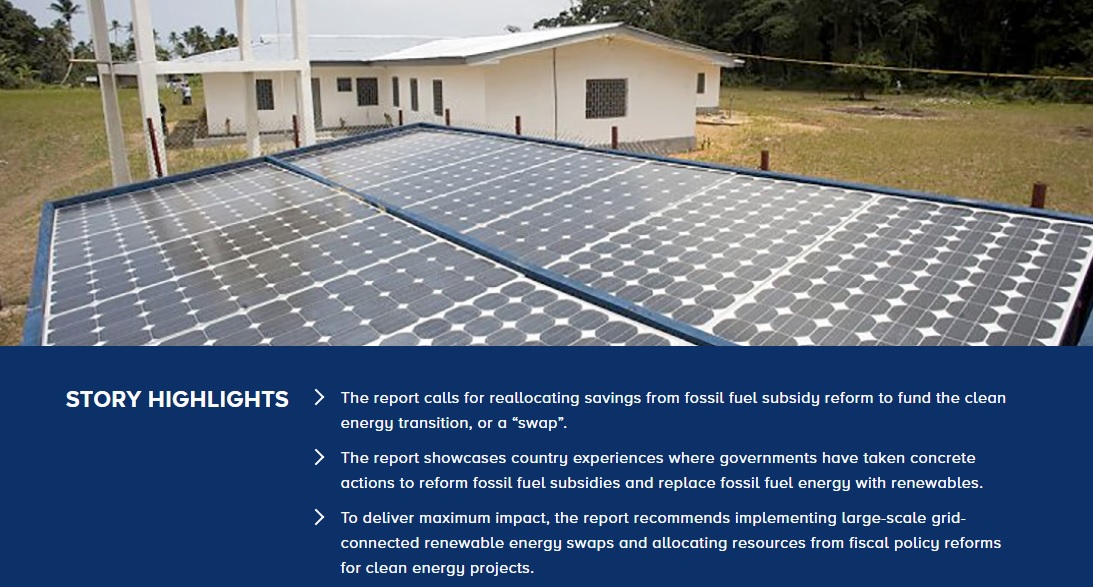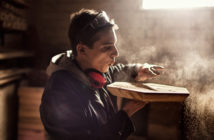SDG Knowledge Hub
CATHERINE BENSON WAHLÉN
STORY HIGHLIGHTS
The report calls for reallocating savings from fossil fuel subsidy reform to fund the clean energy transition, or a “swap”.
The report showcases country experiences where governments have taken concrete actions to reform fossil fuel subsidies and replace fossil fuel energy with renewables.
To deliver maximum impact, the report recommends implementing large-scale grid-connected renewable energy swaps and allocating resources from fiscal policy reforms for clean energy projects.
July 2019: The International Institute for Sustainable Development’s (IISD) Global Subsidies Initiative (GSI) has released a report that calls for policymakers to promote clean energy as part of fossil fuel reforms. The report argues such a “subsidy swap” would bring environmental, economic and social benefits.
The report titled, ‘Fossil Fuel to Clean Energy Subsidy Swaps: How to Pay for an Energy Revolution,’ identifies fossil fuel subsidies as “a key barrier” to a transition to a clean energy system, and asserts that fossil fuel reform alone is “unlikely to deliver the permanent emissions reductions necessary” to meet climate targets. The report calls for reallocating savings from subsidy reform to fund the clean energy transition, or a “swap.” The report argues that such a swap has the potential to magnify the contributions to long-term, permanent emission reductions, public health, gender equality, the economy and jobs.
Globally, the report finds that fossil fuel subsidies have declined, and renewable investments are now higher than investments in fossil fuel-based energy generation. Despite this trend, the report argues that the pace of change “needs to accelerate considerably.” The report recommends addressing political barriers to fossil fuel reforms by developing policies that address the concerns of actors who are neutral or moderately opposed to change and increasing engagement of influential, already supportive actors.
The USD 372 billion countries spend each year on fossil fuels and reallocating 10% to 30% of the savings to renewable energy projects would pay for a transition to clean energy.
UN Secretary-General Antonio Guterres welcomed the report’s findings in a statement calling for action in advance of the UN Climate Action Summit. He said the report found that reforming the USD 372 billion countries spend each year on fossil fuels and reallocating 10% to 30% of the savings to renewable energy projects “would pay for a transition to clean energy.” In India, for example, Guterres noted that “petroleum subsidies have been cut by around 75% since 2014,” which allowed the country to support the development of wind and solar industries. The report further identifies replacing kerosene lighting with cleaner lighting systems as an opportunity for India to continue shifting its resource allocation to support a clean energy transition.
In addition to India, the report showcases country experiences in Indonesia, Morocco and Zambia where governments have taken concrete actions to reform fossil fuel subsidies and replace fossil fuel energy with renewable energy. Indonesia has reformed some fossil fuel subsidies and has demonstrated political willingness to initiate future reforms but has made slow progress in a transition to clean energy, in part due to the relatively high cost of renewable energy. The report suggests that Indonesia can learn from India about how to make renewables more affordable and achieve scale, including by shifting coal sector and liquefied petroleum gas (LPG) subsidy savings towards support for renewables to make them cost competitive.
Morocco aims to achieve 42% renewable energy by 2020 and 52% by 2030. The report finds that Morocco could use fossil fuels subsidy reforms to provide additional financing for scaling up its solar programmes. In Zambia, the report identifies an opportunity to implement energy efficiency in the mining sector, which would, in turn, reduce the sector’s demand for electricity subsidies and subsidy costs for the government. The country also has a high potential for solar energy, which the report finds would further deliver fiscal savings.
To deliver maximum impact, the report recommends implementing large-scale grid-connected renewable energy swaps in emerging economies and allocating resources from fiscal policy reforms to support and leverage finance for clean energy projects. The report argues that large flows of public resources are critical to shift away from fossil fuels and into technologies with large-scale potential for clean energy generation. For countries that have already deployed renewable energy, the report suggests focusing efforts on on-grid, system-wide innovations to improve system flexibility and help balance variable renewable energy, like grid storage and improvements. The report further recommends that governments increase taxes on fossil fuels to continue to simultaneously reduce carbon dioxide (CO2) emissions and generate resources for clean energy. [Publication: Fossil Fuel to Clean Energy Subsidy Swaps: How to Pay for an Energy Revolution] [IISD Press Release] [UN Secretary-General Statement]








